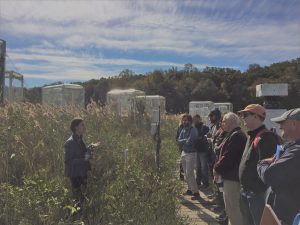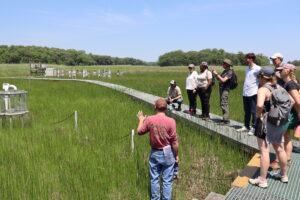Blue Carbon National Working Group

The Blue Carbon National Working Group (BCN) was created in 2015 to coordinate and support actions that lead to increased recognition and application of blue carbon ecosystem values to enhance management of and support for coastal wetland restoration and conservation.
Objectives:
- Increase communication on past, current, and planned blue carbon work at the national, regional, and local scales;
- Increase coordination on future blue carbon projects, including identifying funding opportunities and pilot projects; and
- Provide a platform for discussion of science needs, information gaps, and blue carbon priorities.
BCN Meetings and Outcomes:
BCNWG Meeting One: The BCN first met in May 2015 and resulted in identifying three priority recommendations for advancing blue carbon nationally:
- Develop a database of blue carbon storage, sequestration, and emission factors that can support landscape level carbon accounting on coastal land.
- Develop pilot projects that demonstrate how to implement blue carbon projects and policy, and develop lessons learned from these actions.
- Integrate blue carbon benefits into existing and emerging ecosystem service models and descriptions to more fully account for the full suite of benefits provided by these ecosystems.
BCNWG Meeting Two: The second meeting of the BCN occurred in October 2018, resulting in an an update of progress and set of next steps.The following priority areas were identified from the second BCNWG meeting:

- Protect policies that conserve existing wetlands and restore drained wetlands.
- Identify national restoration potential and quantify the subsequent blue carbon potential.
- Model development and data refinement for blue carbon finance projects; including local and baseline data, transferability of regional models, etc.
- Host trainings for scientists and project developers on VCS methodologies, supporting the need for validators and project developers.
- Develop legal guidance for developing carbon offset projects on government-owned land.
- Engage with diverse funding groups on blue carbon early and often.
- Develop additional outreach tools (e.g., videos, infographics, briefings).
BCNWG Meeting Three: Building on the success of the first two gatherings, RAE hosted the third BCNWG meeting in a completely virtual format in 2021. Thirty-eight experts joined the call to convene over the increased interest in state and federal levels of climate mitigation and the role of coastal blue carbon ecosystems in carbon sequestration.
Discussions from this first meeting noted progress is being made with increased understanding of methane production, finalization of the 2020 conservation methodology for carbon offset verification (VM0007), and the introduction of two bills specifically addressing blue carbon (Blue Carbon for Our Planet Act).
BCNWG Meeting Four:  RAE led a BCNWG meeting on May 21-22, 2024. This meeting was co-hosted by The Pew Charitable Trusts and conducted at their building in Washington DC. A total of 52 people representing a range of state and national governments, non-profit organizations, foundations, academic and research institutions, and the private sector participated in the meeting. The goal of this meeting was to identify ways to coordinate and advance priorities around three areas of focus:
RAE led a BCNWG meeting on May 21-22, 2024. This meeting was co-hosted by The Pew Charitable Trusts and conducted at their building in Washington DC. A total of 52 people representing a range of state and national governments, non-profit organizations, foundations, academic and research institutions, and the private sector participated in the meeting. The goal of this meeting was to identify ways to coordinate and advance priorities around three areas of focus:
- Funding and financing blue carbon
- Improving blue carbon mapping and data
- Advancing blue carbon action at the federal level

